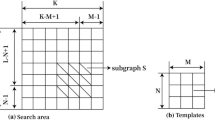Abstract
Unique correct correspondence cannot be obtained only by use of gray correlation technique, which describes gray similar degree of feature points between the left and right images too unilaterally. The gray correlation technique is adopted to extract gray correlation peaks as a coarse matching set called multi-peak set. The disparity gradient limited constraint is utilized to optimize the multi-peak set. Unique match will be obtained by calculating the correlation of hybrid matrices consisting of reference differences and disparities from the multi-peak set. Two of the known corresponding points in the left and right images, respectively, are set as a pair of reference points to determine search direction and search scope at first. After the unique correspondence is obtained by calculating the correlation of the hybrid matrices from the multi-peak set, the obtained match is regarded as a new reference point till all feature points in the left (or right) image have been processed. Experimental results proved that the proposed algorithm was feasible and accurate.
Similar content being viewed by others
References
Akutsu, T., 1994. Efficient and Robust Three-dimensional Pattern Matching Algorithm Using Hashing and Dynamic Programming Techniques. Proceedings of the Twenty-Seventh Annual Hawaii International Conference on System Sciences, Wailea, USA,5:225–234.
Alex, M., Vasilescu, O., Terzopoulos, D., 2003. Multilinear Subspace Analysis of Image Ensembles. Proceedings of 2003 IEEE Computer Society Conference on Computer Vision and Pattern Recognition,2:93–99.
Atallah, M.J., 2001. Faster image template matching in the sum of the absolute value of differences measure.IEEE Trans. on Image Processing,10(4):659–663.
Brünig, M., Niehsen, W., 2001. Fast full-search block matching.IEEE Trans. on Circuits and Systems for Video Technology,11(2):241–247.
Burt, P., Julesz, B., 1980. A disparity gradient limit for binocular fusion.Science,208:615–617.
Grimson, W.E.L., 1985. Computational experiments with a feature based stereo algorithm.IEEE Trans. on PAMI,7(1):17–34.
Guan, Y.P., Tong, L.S., Chen, N., 2003. A study of measurement on deflection yoke based on binocular stereo vision.ACTA ELECTRONICA SINCA,31(9): 1382–1385 (in Chinese).
Ho, W.P., Yip, R.K.K., 1996. A Dynamic Programming Approach for Stereo Line Matching with Structural Information. Proceedings of the 13th International Conference on Pattern Recognition, Vienna, Austria,1: 791–794.
Hu, X.P., Ahuja, N., 1994. Matching point features with ordered geometric, rigidity, and disparity constrains.IEEE Trans. on PAMI,16(10):1041–1049.
Jeon, J., Kim, K., Kim, C., Ho, Y.S., 2001. A Robust Stereo-matching Algorithm using Multiple-baseline Cameras. IEEE Pacific Rim Conference on Communications, Computers and signal Processing,1:263–266.
Kanade, T., Okutomi, M., 1994. A stereo matching algorithm with an adaptive window: Theory and experiment.IEEE Trans. on PAMI,16(9):920–932.
Kanade, T., Yamada, A., 2003. Multi-subregion Based Probabilistic Approach toward Pose-invariant Face Regognition. Proceedings of 2003 IEEE International Symposium on Computational Intelligence in Robotics Automation, Kobe, Japan,2:954–959.
Kim, J.N., Choi, T.S., 2000. A fast full-search motion-estimation algorithm using representative pixels and adaptive matching scan. IEEE Trans. on Circuits and Systems for Video Technology,10(7):1040–1048.
Kittler, J., Christmas, W.J., Petrou, M., 1993. Probabilistic Relaxation for Matching Problems in Computer Vision. Proceedings of Fourth International Conference on Computer Vision, Berlin, Germany, p. 666–673.
Lew, M.S., Huang, T.S., Wong, K., 1994. Learning and feature selection in stereo matching.IEEE Trans. on PAMI,16(9):869–875.
Lu, Y.H., Kubik, K., Bennamoun, M., 1997. Stereo Image Matching Based on Probability Relaxation. Proceedings of IEEE on Speech and Image Technologies for Computing and Telecommunications, Brisbane, Australia,1:315–318.
Okutomi, M., Kanade, T., 1990. A Locally Adaptive Window for Signal Matching. Proceedings of the Third International Conference on Computer Vision, Osaka, Japan, p. 190–199.
Vasilescu, M.A.O., Terzopoulos, D., 2002. Multilinear Image Analysis for Facial Recognition. Proceedings of 16th International Confernce on Pattern Recognition,2:511–514.
Wei, G.Q., Brauer, W., Hirzinger, G., 1998. Intensity- and gradient-based stereo matching using hierarchical Gaussian basis functions.IEEE Transactions on Pattern Analysis and Machine Intelligence,20(11): 1143–1160.
Zitnick, C.L., Kanade, T., 2000. A cooperative algorithm for stereo matching and occlusion detection.IEEE Transactions on Pattern Analysis and Machine Intelligence,22(7):675–684.
Author information
Authors and Affiliations
Corresponding author
Rights and permissions
About this article
Cite this article
Guan, Yp., Gu, Wk. A matching algorithm based on hybrid matrices consisting of reference differences and disparities. J. Zhejiang Univ. Sci. A 5, 796–802 (2004). https://doi.org/10.1631/jzus.2004.0796
Received:
Revised:
Published:
Issue Date:
DOI: https://doi.org/10.1631/jzus.2004.0796




